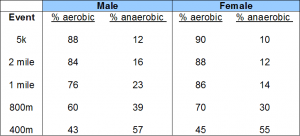 Tapering. It might be one of the most feared words in a runner’s vocabulary, right next to patience and rest. After months of long miles and lung busting intervals, finding the right balance of sharpening and rest to hit race day firing on all cylinders can be a nerve-wracking process. Even more daunting is that the taper isn’t an exact science. Ask any ten coaches and researchers what the optimal taper would be and you’ll get ten different answers.
Tapering. It might be one of the most feared words in a runner’s vocabulary, right next to patience and rest. After months of long miles and lung busting intervals, finding the right balance of sharpening and rest to hit race day firing on all cylinders can be a nerve-wracking process. Even more daunting is that the taper isn’t an exact science. Ask any ten coaches and researchers what the optimal taper would be and you’ll get ten different answers.
However, coaches and scientists do agree on a few principles that are constant in the perfect taper. Unfortunately, these universal elements are also the most frequent aspects most runners botch in the last two weeks of their training. Here’s how you can avoid the three most common tapering mistakes:
Mistake #1: Dropping mileage too much
As race day approaches, many runners significantly reduce their volume in the last 7-10 days before the competition. The conventional theory is that the legs need a rest from all the mileage to perform optimally. However, when we take a deeper look at what effect easy aerobic mileage has on the body, both from a recovery and fitness-building perspective, the fallacy of significantly dropping volume becomes apparent.
By design, easy running is supposed to help you recover. An easy run increases blood flow to the muscles specific to running, helping to clear out waste products and deliver fresh oxygen and nutrients. If you’re recovery runs during the hardest portion of your training cycle have enabled you to adequately recover between hard workouts, what would change the ten days before your race, when you’re not performing intense workouts? Nothing changes. Significantly reducing your mileage does not result in faster recovery or more rested legs if your current volume has allowed you to recover properly during training.
Furthermore, when we look the specific demands of long distance running, we clearly see a heavy reliance on aerobic respiration as a primary energy system:
 Duffield, R., Dawson, B., & Goodman, C. (2005). Energy system contribution to 1500- and 3000-metre track running. Journal of Sports Sciences, 23(10), 993-1002
Duffield, R., Dawson, B., & Goodman, C. (2005). Energy system contribution to 1500- and 3000-metre track running. Journal of Sports Sciences, 23(10), 993-1002
Since the aerobic contribution to events longer than two miles is greater than 85 percent, significantly reducing the specific component of training that provides the most value to aerobic conditioning is flawed. To perform your best, you need to continue to train your aerobic system without producing fatigue.
What you can do
Instead of dropping your total training volume in the last 7-10 days before your race, keep your easy aerobic running at the same mileage as you are adapted to in training. Then, the last 3 days before the race, reduce your volume by 20 percent the third day, 30 percent the second day, and 50 percent the final day before the race. This will eliminate any possible fatigue, yet still allow you to maximize aerobic gains.
Caveat – If you’re tapering for a marathon, you can start reducing volume 5-6 days before the race. The primary difference here is carbohydrate and energy conservation, which doesn’t play a role in events shorter than the marathon.
Mistake #2 – Getting off Your Normal Routine
The body craves consistency. The more routine a runner can be in their training, whether it be the time of day they run or the number of days per week they train, the better the body will respond. Many runners can experience the difference between being on a routine and being inconsistent just by fluctuating the time of day they run. Something as simple as changing your morning run to an afternoon run can make a huge difference in how optimally the body is prepared to perform.
Unfortunately, in an effort to reduce volume or find a magical way to feel more rested, runners with often stray from their normal routine during the taper. Consequently, their legs feel flat or they have less than optimal training runs, reducing confidence heading into the big day.
What you can do
Stay on your routine as best you can. If you normally run five days per week, exercise five days per week. If you double (run twice per day), make sure you have a few double runs thrown in. Do whatever you can to trick your body into thinking the taper is like any other training week.
If you’re nervous about keeping the frequency of training so high, you can turn to other forms of light exercise. When training for big races, I would often go for an afternoon walk when I didn’t have a double run scheduled. My body was so conditioned to running twice per day, it was a great way to keep myself on a consistent routine and to calm the nerves.
Mistake #3 – Thinking The Race is Going to Feel Good
Many runners feel that the taper is going to be some magical process that will make them feel unstoppable on race day. The misleading notion is that the legs will feel so rested and the body so prepared that something special and unbelievable is going to happen on the race course. Sorry folks, not going to happen. Running a PR hurts! No matter how well rested or prepared the body is, racing hurts. If a runner toes the starting line thinking that somehow they’re going to feel anything different, they’re in for a rude awakening half way through the race. Consequently, when the race gets tough, the athlete questions their ability and their training as opposed to accepting the challenge and realizing pushing through the pain is a part of racing.
What you can do
Prepare yourself mentally. Don’t head into the race telling yourself that somehow this race is going to be different. Be prepared for it to hurt, but remember that you’ve trained yourself to push through this exact situation. Visualize the race during your training runs or while meditating and picture yourself hitting that point in the race when your body starts to hurt. Recall those feelings from your last race or hard workout and then visualize yourself pushing through that moment. By preparing yourself mentally, you’ll be ready to face the realities of the race.
Implement these three tips and avoid the most common mistakes when tapering for your next race and you’ll be more consistent with your results.
A version of this post originally appeared at competitor.com



